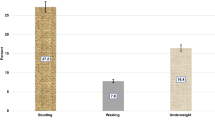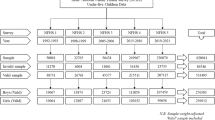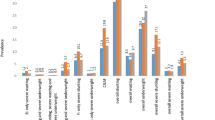Abstract
Objectives:
The objective of this study is to analyze the relationships between undernutrition prevalence rates among children and adults, both at the level of countries and at the level of smaller geographical subunits within countries (districts, provinces). Results are considered of relevance for evaluation and proper usage of anthropometric information in poverty and food security assessment.
Design:
Anthropometric information on both children and adults, as reported in the Demographic and Health Surveys, has been the primary source of data. In addition, data published by WHO, FAO, and data from some country specific reports have been used. The final analysis is based on data from 289 subnational geographical units divided over 56 countries in Africa, Asia and Latin America. Ordinary least squares has been used for regression analysis and F-tests for testing differences of variances.
Results:
At the level of countries, results reveal a strong positive relationship between undernutrition prevalence rates among children and adults. At the level of smaller geographical units, high levels of undernutrition in adult women are almost invariably associated with high levels of undernutrition in children. At the same time, however, low or intermediate levels of undernutrition among adult women are no guarantee that undernutrition levels among children are also low or moderate.
Conclusion:
At the level of countries, information on undernutrition prevalence in children can be considered a proximate of the overall nutritional and food security conditions in a country. At the level of smaller geographical units, relationships are less straightforward, and are hypothesized to depend, at least partially, on the relative importance of food and nonfood factors in the causation of undernutrition.
This is a preview of subscription content, access via your institution
Access options
Subscribe to this journal
Receive 12 print issues and online access
$259.00 per year
only $21.58 per issue
Buy this article
- Purchase on Springer Link
- Instant access to full article PDF
Prices may be subject to local taxes which are calculated during checkout



Similar content being viewed by others
References
Angeles-Agdeppa I, Lana RD & Barba CV (2003): A case study on dual forms of malnutrition among selected households in District 1, Tondo, Manila. Asia Pac. J. Clin. Nutr. 12, 438–446.
Armar-Klemesu M, Ruel MT, Maxwell DG, Levin CE & Morris SS (2000): Poor maternal schooling is the main constraint to good child care practices in Accra. J. Nutr. 130, 1597–1607.
Baulch B & Masset E (2003): Do monetary and nonmonetary indicators tell the same story about chronic poverty? A study of Vietnam in the 1990s. World Dev. 31, 441–453.
Bégin F, Alladoumgué M, Nandjingar K & Delisle H (1992): Household dietary adequacy and individual nutritional status: relationships and seasonal effects in a Sahelian community in Chad. Food Nutr. Bull. 14, 304–313.
Carter MR & Maluccio JA (2003): Social capital and coping with economic shocks: an analysis of stunting among South African children. World Dev. 31, 1147–1163.
DHS (2004): Demographic and Health Surveys, Measure DHS. Calverton, USA: Macro International Inc. Internet:http://www.measuredhs.com.
DHS-Bénin (2002): Enquête Démographique et de Santé au Bénin, 2001, Institut National de la Statistique et de l’Analyse Economique, Cotonou, Bénin – ORC Macro, Calverton, MD, USA.
DHS-Guatemala (1999): Guatemala Encuesta Nacional de Salud Materno Infantil 1998–1999, Measure DHS. Calverton, MD, USA: Macro International Inc.
DHS-Niger (1992): Enquête Démographique et de Santé Niger, 1992, Kourguéni IA, Garba B, Barrère B, Direction de la Statistique et des Comptes Nationaux, Direction Générale du Plan, Ministère des Finances et du Plan, Niamey, Niger. Columbia, MD, USA: Macro International Inc.
Doak CM, Adair LS, Bentley M, Monteiro C & Popkin BM (2005): The dual burden household and the nutrition paradox. Int. J. Obes. Relat. Metab. Disord. 29, 129–136.
Doak CM, Adair LS, Monteiro C & Popkin BM (2000): Overweight and underweight coexist within households in Brazil, China and Russia. J. Nutr. 130, 2965–2971.
Dugdale AE (1985): Family anthropometry: a new strategy for determining community nutrition. Lancet 2, 672–673.
Food and Agriculture Organization (2004): The State of Food Insecurity in the World. Rome: Food and Agriculture Organization.
Florencio TM, Ferreira HS, de Franca AP, Cavalcante JC & Sawaya AL (2001): Obesity and undernutrition in a very-low-income population in the city of Maceio, northeastern Brazil. Br. J. Nutr. 86, 277–284.
Garrett JL & Ruel MT (2003): Stunted child-overweight mother pairs: an emerging policy concern? FCND Discussion Paper No. 148, IFPRI.
James WPT, Ferro-Luzzi A, Sette S & Mascie-Taylor CGN (1999): The potential use of maternal size in priority setting when combating childhood malnutrition. Eur. J. Clin. Nutr. 53, 112–119.
Khor GL & Sharif ZM (2003): Dual forms of malnutrition in the same households in Malaysia – a case study among Malay rural households. Asia Pac. J. Clin. Nutr. 12, 427–437.
Lindtjørn B & Alemu T (1997): Intra-household correlations of nutritional status in rural Ethiopia. Int. J. Epidemiol. 26, 160–165.
McKay A & Lawson D (2003): Assessing the extent and nature of chronic poverty in low income countries: issues and evidence. World Dev. 31, 425–439.
MICS-Niger (2000): Enquête à Indicateurs Multiples de la Fin de la Décennie (MICS2), République de Niger/Unicef.
Monteiro CA, Mondini L, Torres AM & dos Reis IM (1997): Patterns of infra-familiar distribution of undernutrition: methods and applications for developing societies. Eur. J. Clin. Nutr. 51, 800–803.
Norgan NG (1995): Body mass index and nutritional status: the effect of adjusting body mass index for the relative sitting height on estimates of the prevalence of chronic energy deficiency, overweight and obesity. Asia Pac. J. Clin. Nutr. 4, 137–139.
Nubé M (2001): Confronting dietary energy supply with anthropometry in the assessment of undernutrition at the level of countries. World Dev. 29, 1275–1289.
Nubé M, Asenso-Okyere WK & van den Boom GJM (1998): Body mass index as indicator of standard of living in developing countries. Eur. J. Clin. Nutr. 52, 136–144.
Nubé M & van den Boom GJM (2003): Gender and adult undernutrition in developing countries. Ann. Hum. Biol. 30, 520–537.
Pryer JA (1993): Body mass index and work-disabling morbidity: results from a Bangladeshi case study. Eur. J. Clin. Nutr. 47, 653–657.
Ravallion M (1995): Issues in measuring and modeling poverty. Econ. J. 106, 1328–1343.
Sahn DE (2003): Exploring alternative measures of welfare in the absence of expenditure data. Rev. Income Wealth 49, 463–489.
Sahn DE & Stifel DC (2003): Urban-rural inequality in living standards in Africa. J. Afr. Econ. 12, 564–597.
van der Sande MAB, Ceesay SM, Milligan PJM, Nyan OA, Banya WAS, Prentice A, McAdam KPWJ & Walraven GEL (2001): Obesity and undernutrition and cardiovascular risk factors in rural and urban Gambian communities. Am. J. Public Health 91, 1641–1644.
Sichieri R, Coitinho DC, Leão MM, Recine E & Everhart JE (1994): High temporal, geographic, and income variation in body mass index among adults in Brazil. Am. J. Public Health 84, 793–798.
Srinivasan TN (2000): Poverty and undernutrition in South Asia. Food Policy 25, 269–282.
Stephensen CB (1999): Burden of infection on growth failure. J. Nutr. 129 (2S Suppl), 534S–538S.
Stevens J (2003): Ethnic-specific revisions of body mass index cutoffs to define overweight and obesity in Asians are not warranted. Int. J. Obes. Relat. Metab. Disord. 27, 1297–1299.
Swai AB, Kitange HM, Masuki G, Kilima PM, George K, Alberti MM & McLarty DG (1992): Is diabetes mellitus related to undernutrition in rural Tanzania? Br. Med. J. 305, 1057–1062.
Thomas D & Frankenberg E (2002): Health, nutrition and prosperity: a microeconomic perspective. Bull. World Health Organ. 80, 106–113.
United Nations Development Programme (2004): Human Development Report. New York: United Nations Development Programme.
Wijekoon ASB, Thattil RO & Schensul SL (1995): First trimester feeding in a rural Sri Lankan population. Soc. Sci. Med. 40, 443–449.
World Bank (2002): World Development Indicators. Washington: World Bank.
World Bank (2004): World Development Indicators. Washington: World Bank.
World Health Organization (1995a): Physical status: the use and interpretation of anthropometry. WHO Technical Report Series 854. Geneva: World Health Organization.
World Health Organization (1995b): Maternal anthropometry and pregnancy outcomes. A WHO Collaborative Study. Bull. World Health Organ. 73 (Suppl), 1–98.
World Health Organization (2004a): WHO Global Database on Child Growth and Malnutrition. Geneva: World Health Organization. Internet:http://www.who.int/nutgrowthdb/,accessed 26 September 2004.
World Health Organization (2004b): Appropriate body-mass index for Asian populations and its implications for policy and intervention strategies. Lancet 363, 157–163.
Author information
Authors and Affiliations
Corresponding author
Additional information
Guarantor: M Nubé.
Contributors: MN is nutritionist and responsible for study design, analysis and manuscript writing.
Supplementary Information accompanies the paper on the European Journal of Clinical Nutrition website (http://www.nature.com/ejcn)
Supplementary information
Rights and permissions
About this article
Cite this article
Nubé, M. Relationships between undernutrition prevalence among children and adult women at national and subnational level. Eur J Clin Nutr 59, 1112–1120 (2005). https://doi.org/10.1038/sj.ejcn.1602220
Received:
Revised:
Accepted:
Published:
Issue Date:
DOI: https://doi.org/10.1038/sj.ejcn.1602220
Keywords
This article is cited by
-
Determinants of overweight with concurrent stunting among Ghanaian children
BMC Pediatrics (2017)



